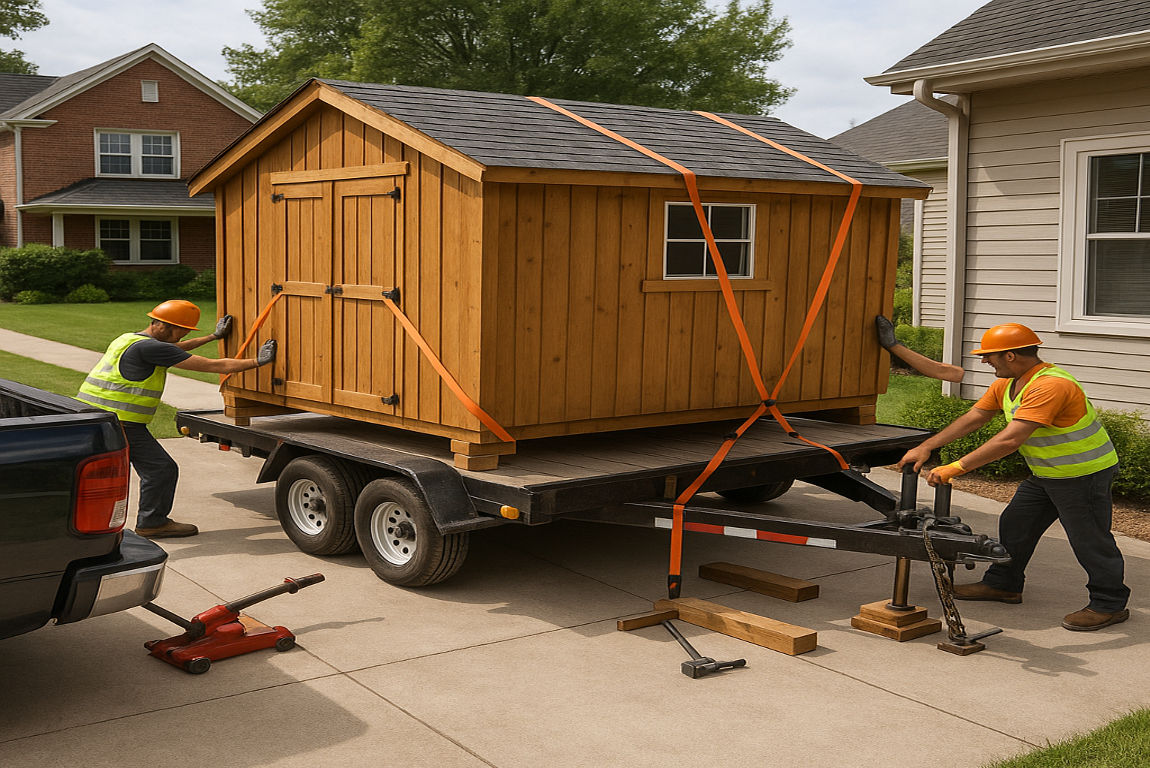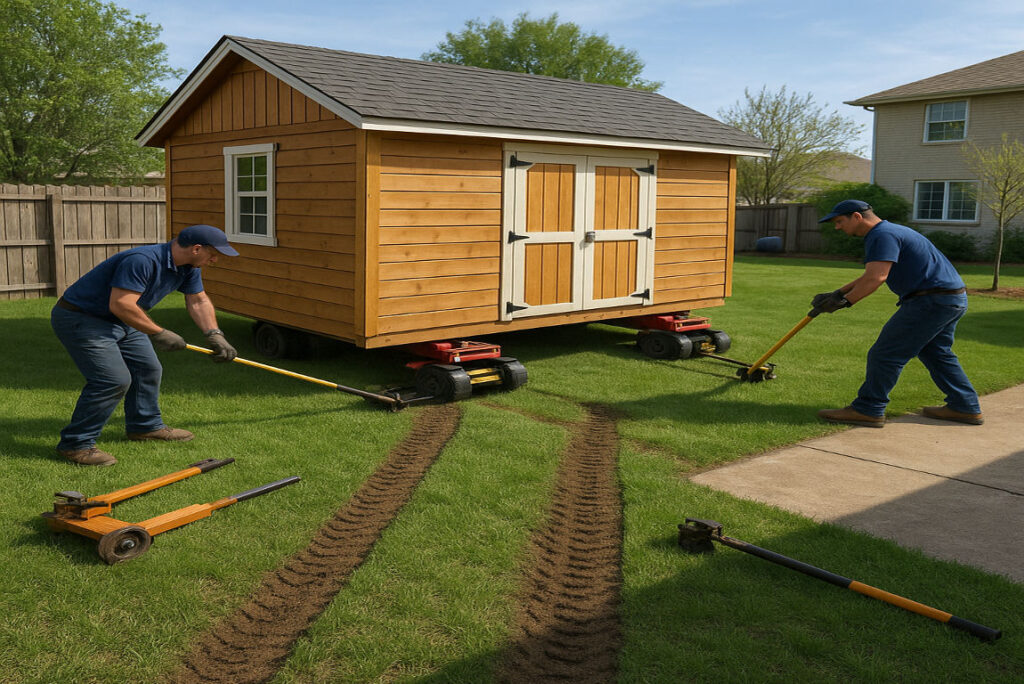Moving to a new home is an exciting chapter in life, but it comes with its fair share of challenges. Among these, one question often arises: “What should I do with my shed?” If you’ve invested time, money, and effort into your shed, leaving it behind might not feel like an option. Whether it’s a custom-built structure or a storage space filled with tools and memories, relocating your shed can be a practical and sentimental decision.
Why Move Your Shed Instead of Buying a New One?

Before we get into the nitty-gritty of moving your shed, let’s address an important question: Why not just buy a new one? While purchasing a new shed may seem more straightforward, there are several compelling reasons to consider relocating your existing one.
Cost Savings
Sheds can be expensive, especially if they’re custom-built or made from high-quality materials. Moving your current shed can save you hundreds, if not thousands, of dollars. The cost of transportation and minor repairs is often far less than the price of a brand-new shed.
Sentimental Value
Your shed might hold more than just tools and equipment—it could be a space filled with memories. Perhaps you built it yourself, or it’s been a part of your home for years. Relocating it allows you to preserve that sentimental value.
Environmental Benefits
Discarding a perfect shed contributes to waste, while buying a new one requires additional resources. By moving your shed, you’re making an environmentally friendly choice that reduces waste and promotes sustainability.
Practicality
If your shed is already customized to meet your needs—whether it’s the shelving, layout, or size—it makes sense to bring it with you. Starting from scratch with a new shed might not offer the same level of convenience.
By understanding how to move a shed from one house to another, you can save money, preserve memories, and make an eco-conscious decision.
You may also read (unlocking the secrets of top home real estate producers).
Assessing Your Shed Before the Move

Before you start planning the move, it’s essential to assess your shed’s condition and determine its suitability for relocation. This step ensures that the process goes smoothly and prevents unexpected issues.
Inspect the Shed’s Condition
Begin by thoroughly inspecting your shed for any signs of damage. Look for:
- Rot or Decay: Check wooden sheds for rotting boards or weak spots.
- Rust: Inspect metal sheds for rust or corrosion.
- Structural Integrity: Ensure the frame, walls, and roof are sturdy and intact.
If you notice any issues, consider repairing them before the move. A structurally sound shed is much easier and safer to transport.
Measure the Shed
Accurate measurements are crucial for planning the move. Use a tape measure to determine the following:
- Length, Width, and Height: Ensure the shed will fit through pathways, gates, or onto a trailer.
- Weight (if possible): Knowing the approximate weight can help you choose the right tools and equipment.
Check Local Regulations
Before relocating your shed, research local zoning laws, permits, or HOA (Homeowners Association) rules. Some areas may have restrictions on shed placement, size, or transportation. Obtaining the necessary permits in advance can save you from legal headaches later.
Evaluate the New Location
Finally, assess the site where you plan to reinstall the shed. Consider:
- Ground Stability: Ensure the ground is level and stable enough to support the shed.
- Drainage: Avoid areas prone to flooding or poor drainage.
- Accessibility: Ensure the site is easily accessible during the move.
Taking these steps will set you up for a smooth and successful relocation.
Tools and Equipment You’ll Need
Having the right tools and equipment is essential for safely moving your shed. Here’s a breakdown of what you’ll need:
Essential Tools
- Jacks: To lift the shed off the ground.
- Dollies or Rollers: For moving the shed short distances.
- Straps and Ropes: To secure the shed during transportation.
- Planks or Boards: To create a stable surface for rolling or lifting.
Heavy Equipment (if needed)
For larger or heavier sheds, you may need to rent or hire specialized equipment, such as:
- Flatbed Trailer: Ideal for transporting sheds over long distances.
- Forklift or Crane: Useful for lifting particularly heavy sheds.
- Truck with a Winch: To pull the shed onto a trailer.
Safety Gear
Don’t forget to prioritize safety! Equip yourself with:
- Gloves: To protect your hands.
- Goggles: To shield your eyes from debris.
- Steel-Toed Boots: To prevent foot injuries.
By gathering these tools and equipment, you’ll be well-prepared to tackle the move.
You may also read (how to estimate the cost to rewire a house in the uk).
Step-by-Step Guide to Moving Your Shed

Now that you’ve assessed your shed and gathered the necessary tools, it’s time to get moving! Follow these steps to ensure a smooth relocation process.
Prepare the Shed for the Move
- Empty the Shed: Remove all items to reduce weight and prevent damage.
- Detach Removable Parts: Take off doors, windows, or shelves to make the shed lighter and less prone to damage.
Plan the Route
- Measure Pathways: Ensure the shed can fit through gates, driveways, or other narrow spaces.
- Clear Obstacles: Remove rocks, branches, or debris from the path.
Lift the Shed
- Use jacks or levers to lift the shed off the ground.
- Place planks or rollers underneath to facilitate movement.
Transport the Shed
- Manual Moving: Use dollies or rollers for short distances.
- Trailer Transport: Load the shed onto a flatbed trailer for longer distances.
- Hire Professionals: For large or heavy sheds, consider hiring experts to ensure proper installation and safety.
Reinstall the Shed
- Level the Ground: Ensure the new site is flat and stable.
- Anchor the Shed: Use stakes or anchors to secure the shed and prevent shifting.
Common Challenges and How to Overcome Them

Moving a shed isn’t without its challenges. Here are some common issues and how to address them:
ChallengeSolution
The shed is too heavy. Break it down into smaller parts or hire professionals.
Narrow pathways: Disassemble the shed or use specialized equipment.
Permits and regulations: Research local laws and obtain necessary permits in advance.
When to Hire Professionals
Sometimes, it’s best to leave the heavy lifting to the experts. Here’s when you should consider hiring professionals:
- The shed is too large or heavy.
- You lack the necessary tools or equipment.
- The route is complex or involves long distances.
Hiring professionals can save time, reduce stress, and ensure the job is done safely.
Tips for Maintaining Your Shed After the Move
Once your shed is in its new location, proper maintenance is key to ensuring its longevity. Here are some tips:
- Inspect for Damage: Check for cracks, loose screws, or other issues after the move.
- Repaint or Reseal: Protect the shed from weather damage by applying a fresh coat of paint or sealant.
- Organize the Interior: Use shelves, hooks, and bins to keep the shed tidy and functional.
You may also read (what causes maggots to appear in my house).
